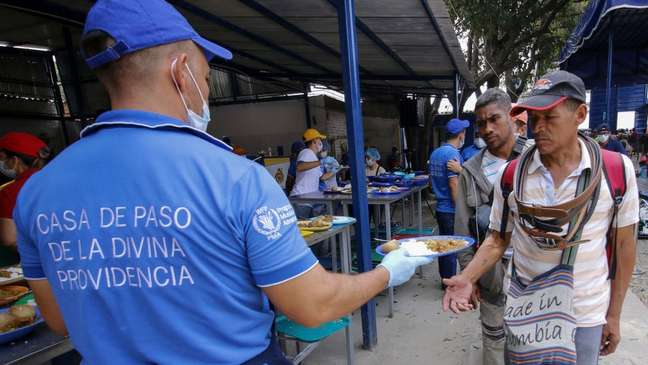The great efforts that many Latin American countries have had to make in the face of the massive arrival of Venezuelans could end up helping their economies grow, according to an IMF study.

When you hear the phrase “Venezuelan migration crisis,” what images come to mind?
If you Google that phrase, the photos you’ll see show long lines of people carrying backpacks or lugging suitcases as they try or wait to cross a border. Or parents carrying small children, heartbreaking hugs, camping and exhausted faces.
The wave of migration from Venezuela is a consequence of a huge economic collapse that occurred between 2013 and 2021, which reduced the country’s GDP by more than 75% and has caused the departure of 7 million people so far. Of these, about 6 million are in Latin American and Caribbean countries.
This massive arrival of Venezuelan immigrants, who in many cases need immediate attention – including the most basic issues such as food, shelter, medicines, vaccines, education for children – has had a significant impact on the host countries. This was because these nations had to make a significant effort to welcome the newcomers.
Calculations by the authorities in Colombia – which received the largest number of Venezuelans (about 2.5 million by December 2022) – indicate that in 2019 the country allocated about 600 dollars (R$3,171) for each migrant. This translates into spending $1.3 billion (R$6.8 billion) on assistance to newcomers, equivalent to 0.5 percent of Colombia’s GDP.
But there are two good news.
This should be the maximum cost of serving Venezuelans in all countries in the region and, in fact, this impact will diminish over time as these migrants integrate into the local economy.
This integration not only helps offset the costs incurred, but is estimated to generate GDP growth of up to 4.5% by 2030.
All this, according to a new study by economists of the International Monetary Fund (IMF) entitled “Regional Spillover from the Venezuelan Crisis”.

An expense that becomes an investment
According to the survey, spending on meeting the needs of Venezuelan migrants varies between 0.1% and 0.5% of GDP, depending on the country.
It is estimated that between 2020 and 2025 it will be around 0.4% in the case of Colombia; 0.25% for Ecuador and Peru and 0.1% for Chile.
The massive arrival of migrants also has repercussions on the initially heterogeneous labor market.
“As most migrants get a job (even if it doesn’t match their qualifications), total employment increases and real wages decrease. Lower wages discourage some local workers from participating in the labor market. While overall unemployment increases the unemployment rate of immigrants slightly exceeds that of local workers,” the report said.

“Despite these effects, global labor income increases in line with global employment growth. For companies, lower real wages translate into lower production costs and higher profits,” he adds.
Jaime Guajardo, lead author of the IMF study, points out that it is so far difficult to assess the contribution of Venezuelan migration to the GDP of the beneficiary countries due to the fact that these effects require time and limitations in the availability of recent data on employment rates or the type of work performed by immigrants, partly due to the pandemic.
Despite this, in the study they made estimates of GDP increases in these countries between 2016 and 2030, taking two different scenarios: one without immigrants and the other with them.
To calculate the latter, they assumed that, in principle, most migrants would get unskilled jobs in the informal economy and that, in subsequent years, only a fraction of them would enter the formal sector with jobs commensurate with their capital. human. This would increase the productivity of the economy in the medium term.
“According to these estimates, the GDP of Colombia, Chile, Ecuador and Peru – countries that have received 69% of Venezuelan migrants – would have increased between 1.5% and 2.5% compared to a scenario without migration, between 2016 to 2022. And it is expected to increase between 2.5% and 4.5% by 2030,” Guajardo told BBC News Mundo in an email interview.
The most favored countries
The IMF study took numerous factors into account in its calculations: from the impact of migration flows on employment and productivity, passing through the percentage of immigrants of working age and their level of education. It also took into account labor market conditions, the climate, how long it takes migrants to find a job, what type and in which sector of the economy.
According to this analysis, the country where Venezuelan migration will have the greatest impact on GDP growth until 2030 will be Peru (4.4%), followed by Colombia (3.7%), Ecuador (3.5%), Chile (2.6%), Panama (1.9%), Dominican Republic (1.1%), Costa Rica (0.6%) and Uruguay (0.6%).

Guajardo indicates that the impact on GDP is greatest in countries that receive the largest migratory flows of working age and where migrants are more skilled than the local population.
“Given its proximity to Venezuela, Colombia has received a higher percentage of migrants outside working age (children or the elderly) and a higher percentage of migrants with less years of schooling, many of whom cannot afford transport to countries further away from the Venezuelan region. This explains why the impact on Colombia’s GDP is smaller than the GDP of Peru, despite the fact that Colombia has received greater migratory flows than its population,” he stresses.
It should be noted that these projections through 2030 are based on the premise that Venezuelan migration will continue to grow to 8.4 million people in 2025, which is more than 25% of the population Venezuela had in 2015.
This will require host states to maintain policies of welcoming and supporting new arrivals, with humanitarian aid and access to education, health care and basic services.
But what can these countries do to maximize the impact of the arrival of Venezuelan immigrants on their GDP?
Guajardo recommends facilitating the integration of migrants into the formal labor market, granting work permits and validating studies and academic qualifications.
“This allows migrants to find work commensurate with their level of education and thus increase the productivity of the economy. It would also reduce the cost for governments to provide humanitarian aid and access to education, healthcare and basic services , as migrants could pay part of these expenses themselves and would pay taxes,” he says.
“In this way, the tax burden initially incurred would be more than offset in the medium term,” he concludes.
– This article was originally published in https://www.bbc.com/portuguese/internacional-64130969
+The best content in your email for free. Choose your favorite Terra newsletter. Click here!
Source: Terra
Camila Luna is a writer at Gossipify, where she covers the latest movies and television series. With a passion for all things entertainment, Camila brings her unique perspective to her writing and offers readers an inside look at the industry. Camila is a graduate from the University of California, Los Angeles (UCLA) with a degree in English and is also a avid movie watcher.





